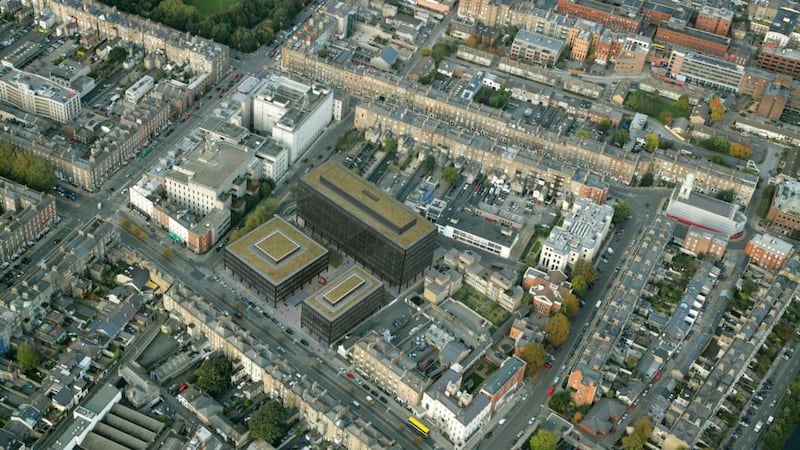An international marketing campaign later this month will seek suitable tenants for the former Bank of Ireland headquarters on Lower Baggot Street in Dublin 2 which is being remodelled and redeveloped at a cost of around €100 million.
The huge rejuvenation project – easily the largest ever involving a Dublin office building – is being promoted and funded by the meat baron Larry Goodman whose Parma Developments acquired the complex in 2013 for just over €40 million.
In 2008 the HQ was sold to the Landmark consortium headed by Derek Quinlan and Paddy Shovlin for €180 million.

Their plans for the centre were disrupted, first by a planning refusal and later by Dublin City Council’s decision to designate it as a protected structure. Even more disastrous for the group of investors, was the property crash which quickly followed.
Since buying the building Goodman has assembled an international design team led by original architects Scott Tallon Walker, to bring the 1960s and 1970s offices up to the highest standards. Once the ongoing work is completed and the largest of the three blocks is extended by a single bay to the rear, there will be an overall floor area of 20,345sq m (219,000sq ft) of lettable space.
The two smaller blocks, which are expected to be ready for fit out in the first quarter of next year, extend to 4,180sq m (45,000sq ft) and 288sq m (31,000 sq ft). The rear block of 13,284sq m (143,000sq ft) is due to be completed towards the end of next year. There will be 125 parking spaces at basement level.
Letting agent Declan O'Reilly of Knight Frank says the market is waiting with a high degree of expectation for the "wrapper to come off" the building.
He believes it will have wide appeal across all sectors including technology and professional services as well as the public sector given the proximity to Government Buildings.
Rents for the newly named Miesian Plaza are not being formally quoted yet but market sources believe that with a redevelopment spend of €100 million they are likely to be in the region of €645 per sq m (€60 per sq ft).
Project architect Ronan Phelan of Scott Tallon Walker says their goal is to provide Grade A office accommodation of the highest modern standard to equal or surpass the finest developments in the market. To achieve the highest credentials, the developer is targeting a Leed (Leadership in Energy and Environmental Design) Platinum rating, espoused by green building councils across the globe .
Much of the importance of the former bank building derives from the fact that it is modelled on architect Mies van der Rohe's modernist Seagram Building on New York's Park Avenue. However, Seagram is a 38-storey skyscraper whereas the former bank HQ is composed of three relatively low rise buildings.
The biggest impact of the redevelopment both visually and in terms of occupant comfort will be the upgrading of the exceptional bronze curtain wall on all three blocks.
Around €20 million alone is being spent on renovating the façade: installing new high performance glass, thermal insulation and modern draught and weather seals that will guarantee a high performance building.
New motorised internal blinds linked to a façade management system are also being installed to control solar gain and glare for maximum occupant comfort.
The project team has gone to considerable trouble to determine how best to clean and restore the patina of the bronze to its original colour.
Experts were traced to the UK and hired-in to restore the bronze cladding.
The decision by the promoters to clean back and repatinate the bronze cladding is further evidence of their determination to restore the original noble finish.
The biggest change will be made to Building 1, the largest of the three blocks.
It is to be extended by one full bay –-80m long by 6.5m deep- along the full length to the rear. The façade on this elevation will be simply removed and reinstated in its new location. The gable ends of the new extension will be clad in new bronze, specially cast and fabricated in Switzerland to replicate the existing refurbished cladding.
The extension will add 3,660sq m (39,395 sq ft) of net lettable area to the existing scheme while also delivering an impressive open plan-floor plate – 26m deep by 80m long – over seven floors. At ground floor level of Building 1 the impressive entrance hall will be restored to its former glory with the removal of a mezzanine floor installed in the 1980s. The reconfigured lift cores will open up the arrival space into the building to create a dramatic open-plan reception area.
Internally the building cores have been redesigned to comply with modern standards.
The centrally located cores – to include toilets, lifts, air conditioning system and other building services – will allow each block to have floor-to-ceiling glazing on all four sides to avail of natural light and views. The new layout will also include raised access floors and suspended ceilings.
Apart from the huge task of upgrading the façade of the building, other design features will also include roof gardens, rainwater reuse, reclaimed heat energy, sustainable material use and other smart building technologies – a range of elements that could catapult the building into one of the highest achievable classifications in the world of sustainable building design.













